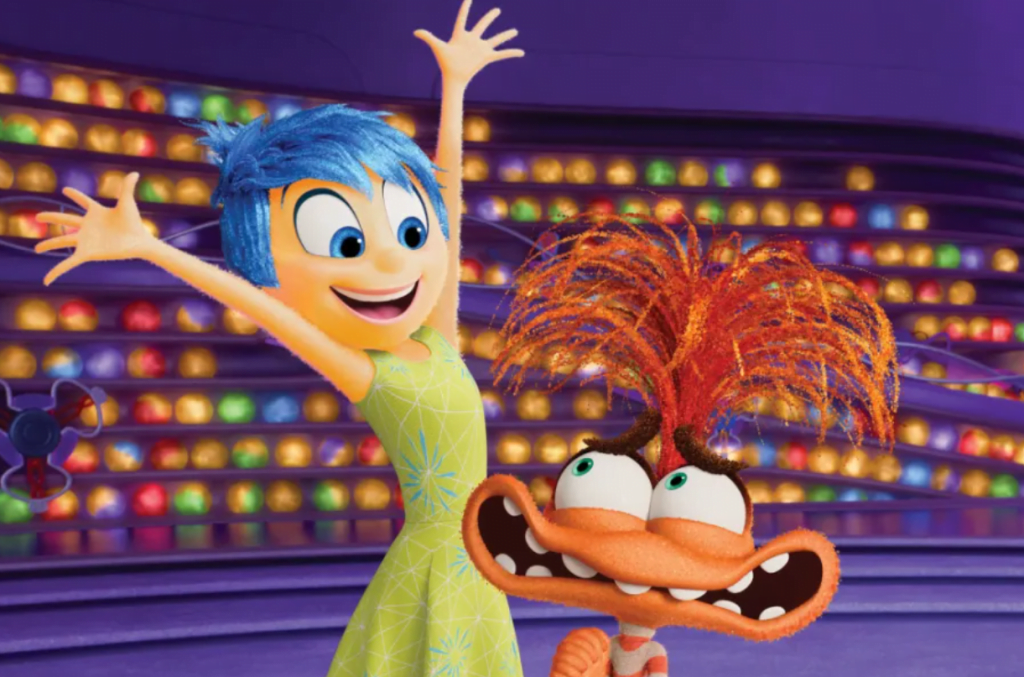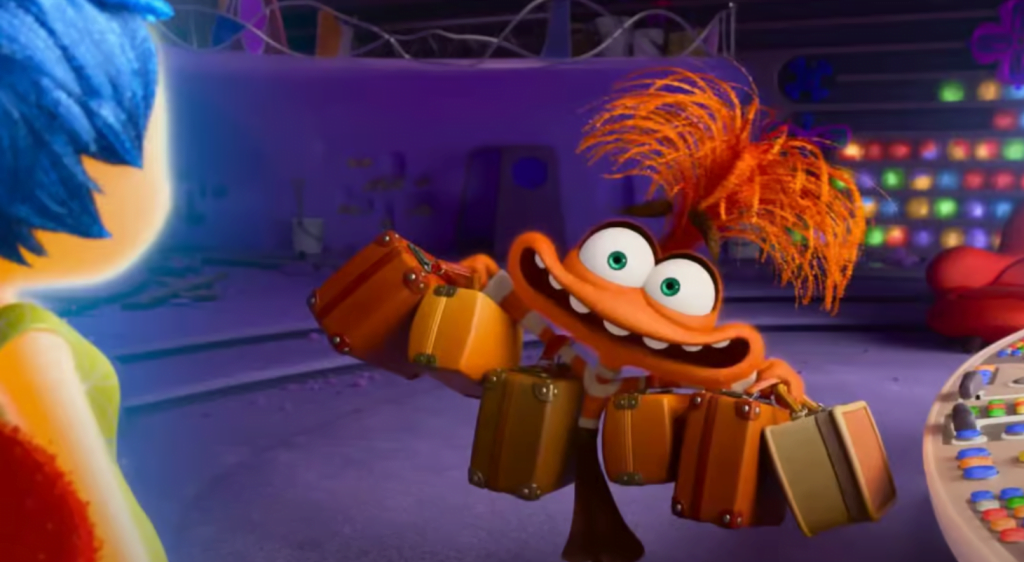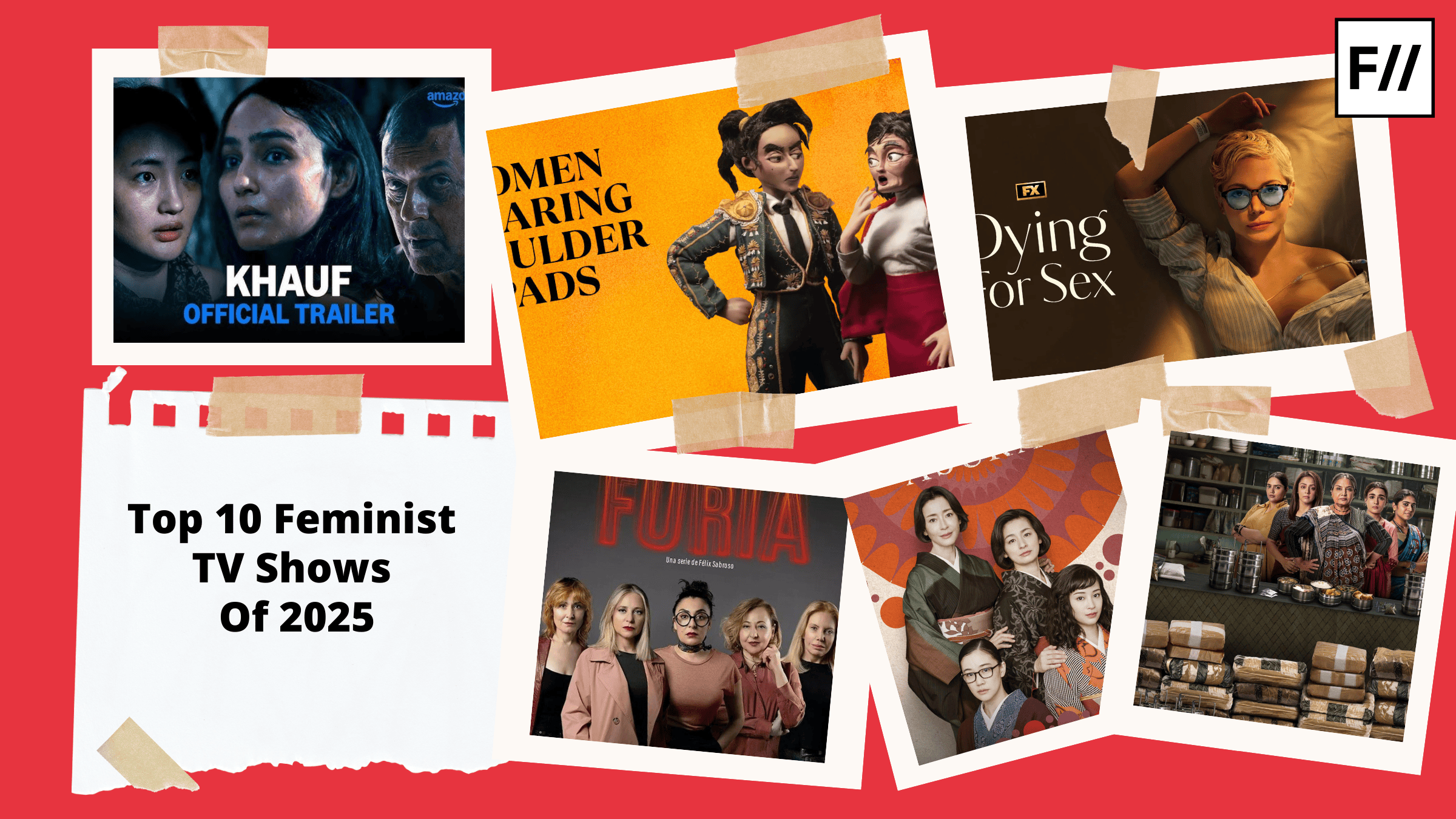In 2015, Pixar dropped the first Inside Out, a hilarious and inventive film depicting the inner workings of an 11-year-old girl named Riley. The film personifies her core emotions—Joy, Sadness, Anger, Fear, and Disgust—and shows them struggling to guide her actions after she moves to a new city.
Nine years later, Pixar has released Inside Out 2, which builds on the brilliance of its predecessor and plunges into the emotional minefield of teenage girlhood. Two years after the first film, the sequel begins with Joy & Co. still running “Head“-quarters, with Joy predominantly controlling the console to the now 13-year-old Riley’s emotions. We are introduced to a new concept called Riley’s Sense of Self, which is a lake containing Riley’s core memories which all form the stems of a tree symbolising Riley’s belief system. Joy, who clearly has not learnt much from Part 1, curates memories that shape Riley’s Sense of Self, only allowing the happy ones to float in the lake while ejecting uncomfortable ones to the “back of her mind.” This selective process reinforces Riley’s internal mantra, “I am a good person.“
All is well until one night, the “Puberty Alarm” strikes, bringing four new, unwanted emotions to Headquarters: Ennui, Embarrassment, Envy, and the not-so-villainous villain Anxiety.
The arrival of these emotions mirrors upheavals in Riley’s external world, such as her friends switching schools and the pressures of hockey camp, leading to an influx of questionable friends, choices, and emotions. In a bid to help Riley navigate these changes, Anxiety exiles the OG emotions from Headquarters, along with her existing Sense of Self, declaring complete control over Riley’s console. She begins crafting Riley’s new Sense of Self – one that is stronger, meaner, and willing to bulldoze years of friendships to “fit in” with the cool clique at camp. The plot follows Joy & Co.’s journey back to Headquarters, to dethrone Anxiety and restore Riley’s original Sense of Self.
A fresh take on the coming-of-age classic
Coming-of-age films typically reduce a girl’s adolescence to external milestones: her first love, heartbreak, period, or even first pimple. While these serve as visible indicators of “growing up,” what remains unexplored are the complex psychological changes that teenage girls undergo during this period. Through the introduction of characters like Anxiety, Embarrassment, and Envy, Inside Out 2 highlights an overlooked part of growing up as a girl: the ability to picture yourself from the outside.

This cognitive shift allows girls to critically evaluate their self-worth based on societal expectations or the perception of others, as represented by Riley’s Sense of Self. This leads to an influx of self-conscious emotions – getting embarrassed, envying what others have, or feeling anxious about the future. While it would have been uplifting to see more “positive” emotions also being introduced, such as empathy, love, or lust, Inside Out 2 shifts the gears of adolescence ever so slowly, zeroing in on those years when a girl learns to love herself, intentionally separating this journey from the cliche coming-of-age narratives that focus on girls learning to love others.
Celebrating emotional complexity
Perhaps the most bittersweet moment of the film is when Joy returns to Headquarters, ready to end Anxiety’s dictatorship. However, she finds a turbulent orange storm whizzing around Riley’s mind, at the centre of which is tiny, teary-eyed Anxiety, frozen in place. After overwhelming Riley’s mind with hypothetical fears, Anxiety had caused Riley to hyperventilate in a scene that feels painfully familiar. In essence, she had unknowingly given Riley an Anxiety attack.
What Inside Out 2 achieves beautifully is that it challenges the stigmatisation and demonisation of these pathologised emotions by giving each one a distinct identity and character arc in Riley’s life. It tactfully presents the unhealthy and healthy sides of these emotions and shows them playing vital social and developmental roles in her well-being: Sadness promotes healing. Embarrassment leads to social awareness. Envy fuels ambition. Anxiety prepares us for what could go wrong.
“I’m sorry, I was just trying to protect her,” whispers Anxiety.

Initially presented as an all-consuming villain, we soon realise that Anxiety was never trying to harm Riley; she was just trying to protect her “from the scary stuff she can’t see.” She was preparing for a future where Riley succeeded in hockey. Where Riley was considered cool. Where she had friends.
When society broadly labels women as “emotional,” they are referring to traditionally ‘feminine‘ emotions associated with self-consciousness – insecurity, jealousy, vulnerability and of course the irrational fear that is Anxiety. What Inside Out 2 achieves beautifully is that it challenges the stigmatisation and demonisation of these pathologised emotions by giving each one a distinct identity and character arc in Riley’s life. It tactfully presents the unhealthy and healthy sides of these emotions and shows them playing vital social and developmental roles in her well-being: Sadness promotes healing. Embarrassment leads to social awareness. Envy fuels ambition. Anxiety prepares us for what could go wrong.
Conversely, it shows that life cannot be navigated solely by Joy.
There come moments where we see Joy, the most “wanted” emotion, failing to navigate social situations appropriately. Her constant push for positivity becomes overwhelming and “delusional,” exemplifying the impacts of toxic positivity. This message hits harder when Joy struggles to defeat Anxiety and cracks under pressure- “Do you know how hard it is to be positive ALL THE TIME?” This moment teases at the frustration and emotional fatigue women often feel under the social pressure to “smile” and “cheer up” for the sake of social harmony, whilst aggression and outbursts are deemed appropriate emotional outlets for boys. It makes us question society’s biased view of “good” mental health and advocates for a definition that is more realistic, nuanced and inclusive.
That is why Inside Out 2 never makes Joy the hero who rescues Riley from Anxiety. Instead, the film concludes in a grey area where the emotions end their power struggle in an adorable group hug, symbolising emotional harmony and self-awareness. And that is because Anxiety is not a flaw that can be “cured” – it is a part of life. Instead of suppressing Anxiety with superficial Joy, the first step to addressing it is accepting that it’s even there.
By giving a face to the little Anxieties in our minds, Inside Out 2 offers emotional literacy and awareness during a time fraught with identity and self-worth issues. It helps young girls picture and comprehend uncomfortable, yet widespread emotions that society often dismisses as ‘dramatic,’ ‘emotional,’ and ‘out–of-control.’ The film reminds us that these emotions can cause us to act impulsively, not out of cruelty, but out of self-preservation, and normalises them as part of a healthy emotional landscape.
All in all, it prompts us to forgive those irrational little orange creatures inside our heads.
Rejecting perfectionism Inside Out
Anxiety succeeds in carving a Sense of Self-based on Riley’s hypothetical fears of failure, altering her mantra to “I am not good enough.” These fears stem from the pressure to succeed and impress, reflecting societal standards that equate a woman’s worth with external achievements.

Riley’s panic attack only resolves when Joy and Anxiety both step back, allowing a new, authentic Sense of Self to emerge. This new identity, guided by all of Riley’s authentic emotional experiences, encompasses both her positive and negative self-beliefs. It highlights that true self-acceptance lies in embracing one’s full emotional spectrum rather than conforming to society’s portrait of an “ideal” woman and her hunger for perfectionism.
Inside Out doesn’t end with Riley being prom queen and winning a boyfriend, it ends with her accepting her multifacetedness: a good friend who can also be mean, honest yet prone to mistakes, and a worthy person with flaws. This complexity steps away from presenting women as one-dimensional and embraces their diverse and sometimes contradictory traits.
With Riley’s new Sense of Self-formed, specks of gold dust fly from Joy to Riley’s console. In that moment, Riley chooses to feel Joy, because she finally feels worthy of it, thereby reclaiming her emotional autonomy. Her emotions are meant to guide her, not define who she is. Inside Out 2 ends by emphasising that even though women can be “emotional,” they are much more than the sum of their emotions.
Inside Out 2 and female friendships
Do you really think Riley could’ve had these profound, life-changing epiphanies by crushing on a boy?

As much as Inside Out 2 focuses on how Riley’s emotions impact her external world, the film is equally “Outside In,” as it makes the evolving dynamics of her female friendships the centre of her emotional breakdown. While the film highlights the profound impact and significance of female friendships during our teenage years, it doesn’t shy away from addressing the common sexist stereotypes of jealousy, competition, and cliqueness attached to girl gangs.
Inside Out 2 illustrates that while girls can indeed get competitive and envious (like boys), these feelings are usually driven by self-preservation, not “bitchiness.” Riley’s emotional breakthrough leads her to apologise and express her anxieties to her friends. It demonstrates that while female friendships can involve competition and jealousy, they are also rich in trust, communication, acceptance, and forgiveness. Overall, the film celebrates the authenticity and beauty of female bonds, emphasising their significance in emotional growth and personal development.
In a world that constantly critiques women for being “too emotional,” yet continues to sideline these emotional experiences, it is finally refreshing to see a film that gives each of these individual emotions the attention they deserve. Inside Out 2 is a film that transcends reductive stereotypes about women and male-centric narratives that valorise stoicism and emotional suppression. It never attempts to dismantle the age-old stereotype that girls are “emotional.” Instead, it agrees. Girls ARE emotional. And that’s okay, because emotions, even the socially demonised ones, are vital to personal growth and self-discovery.
Inside Out 2 is a celebration of a woman’s full humanity. It reminds us that womanhood must be experienced in a spectrum of colours, even though occasionally, that colour may include a vibrant shade of orange.




